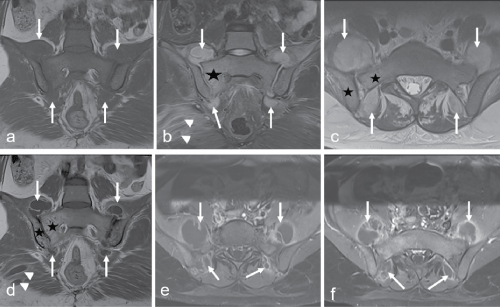A 21-year-old female patient applied to our hospital with gluteal and lumbar pain. Physical examination revealed tenderness in the bilateral sacral-lumbar area and limitation of the bilateral hip joint. Sacroiliac joint MRI showed the bone marrow oedema, overlying soft tissue swelling, right gluteal muscles abscess and multilocular abscess involving the bilateral sacroiliac joint (Figure 1). Pyogenic sacroiliitis of sacroiliac joint is seen rarely, representing 1-2% of all cases of septic arthritis [1]. The most frequent symptom is lumbogluteal pain and the diagnosis is difficult because of the lack of symptom specifity. Staphylococcus aureus is the most detected organism in cases of pyogenic sacroiliitis [1,2]. In our case, the abscess was drained with percutaneous surgical approach and the patient responded well to antibiotic therapy.
None.
None.
The authors declare that they have no any conflict of interest.

Figure 1: Coronal T1 weighted image (a), coronal (b) and axial (c) T2 weighted images, contrast enhanced coronal T1 (d) and fat saturation axial (e,f) T1 weighted images show the bone marrow oedema in right sacroiliac joint (star), overlying soft tissue swelling, right gluteal muscles abscess (arrowheads) and multilocular abscess involving the bilateral sacroiliac joint (arrows). Contrast enhancement was seen in bone marrow eodema regions compatible with sacroilitis (star). Fluid collections competible with multilocular abscess was showed peripheral enhancement (arrows).